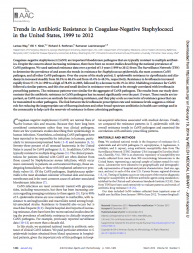January 16, 2014

The Question
How prevalent is S. epidermis, the most common Coagulase-negative staphylococci (CoNS) pathogen, and what are trends in its resistance profile? How does this compare to all other CoNS pathogens?
What we found
Using national resistance data from The Surveillance Network recorded over a period of 13 years (1999-2012), we determined that resistance to ciprofloxacin and clindamycin increased steadily from 58.3% to 68.4% and from 43.4% to 48.5%, respectively. Resistance to levofloxacin increased rapidly from 57.1% in 1999 to a high of 78.6% in 2005, followed by a decrease to 68.1% in 2012. Multidrug resistance for CoNS followed a similar pattern, and this rise and small decline in resistance was found to be strongly correlated with levofloxacin prescribing patterns. Resistance patterns were similar for the aggregate of CoNS pathogens. The results from our study demonstrate that antibiotic resistance in CoNS pathogens has increased significantly over the past 13 years.
Why it matters
As CoNS can serve as sentinels for monitoring resistance and they play a role as a reservoir of resistance genes that can be transmitted to other pathogens. The link between the levofloxacin prescription rate and resistance levels suggest a critical role for reducing inappropriate use of fluoroquinolones and other broad-spectrum antibiotics in both healthcare settings and the community to help curb resistance.

